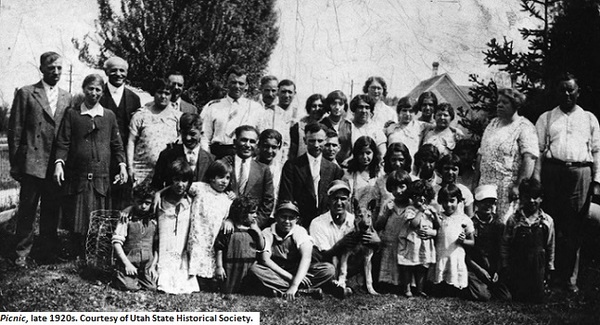Dublin Core
Title
Description
The journey of Martha Sharouk – a young wife who left Lebanon and travelled to Utah to begin a new life – did not quite go as planned…
In the winter of 1913, a young Lebanese woman stepped off the train at the Denver and Rio Grande station in downtown Salt Lake City. Martha Sharouk had come to Utah to join her husband, Bolos. Like millions of others, the Sharouks looked to the United States for a new life and new opportunities.
But leaving her homeland had devastated Martha. As she boarded the ship, emigration officials discovered that her baby had an eye infection, and made Martha leave the child behind with his grandmother. Without her child or husband, Martha wept as she journeyed to America. The only English word she knew was “banana,” so she ate almost nothing else throughout that long and lonely voyage.
Now, in Utah, Martha stood in a snowstorm on the train platform, waiting for her husband. He never came. Finally, a stranger in a buggy took her to Fourth South and pointed the way toward the Arabic community. She walked through the freezing snow, lost, until she happened upon an old friend from Lebanon. Martha's husband, the friend told her, had gone to Portland to find work.
When the two were finally reunited, Martha and Bolos opened a grocery story on Second South in Salt Lake City and became part of a close-knit Lebanese immigrant community.
The Sharouks were part of a great wave of immigrants who came to work and live in this country during the early 20th century. But immigration was controversial then as now. Many Americans feared the different cultures – and faces – of the immigrants. So, during the 1920s, Congress passed laws severely limiting the numbers of Asians and Eastern and Southern Europeans who could enter the country by imposing literacy tests and convoluted quotas based on national origin.
Such fears against people who are different have played out in many times and places, but Utah is richer and stronger because of its many immigrant groups.
Creator
Kristen Rogers Iversen for the Utah Division of State History © 2014
Source
Image: Picnic, late 1920s. Salt Lake Lebanese attending a picnic in Logan. Immigrant communities throughout the state were tight knit, and provided resources and comfort for recent immigrants. Courtesy of Utah State Historical Society.
_______________
Martha Sharouk's story is from an interview by Kristen Rogers of Helen Anton, the Sharouks' daughter, in 1998. See Beehive History 24 for more of the family's story. For more on the experience of Europeans in Utah, see “Toil and Rage in the New Land,” by Helen Papanikolas, in Utah Historical Quarterly 38:20 (April 1970). For information on laws limiting immigration, see the U.S. Department of State Office of Historian at https://history.state.gov/milestones/1921-1936/immigration-act.
Publisher
The Beehive Archive is a production of Utah Humanities. Find sources and the whole collection of past episodes at www.utahhumanities.org
Date
2014-06-06

